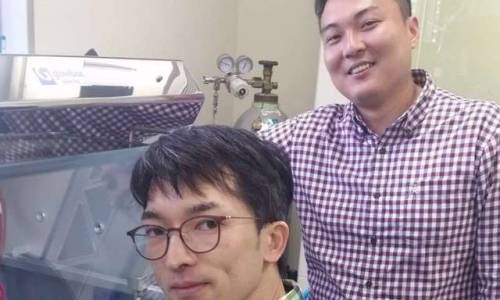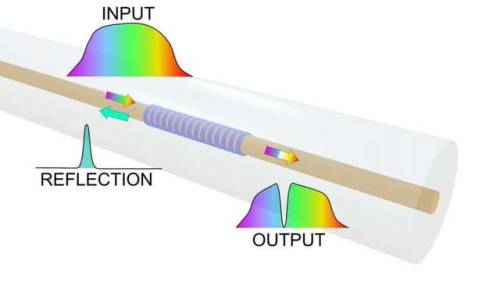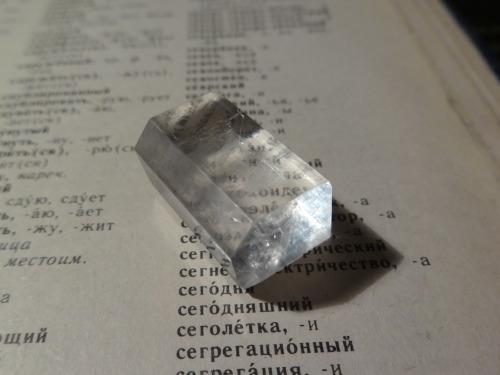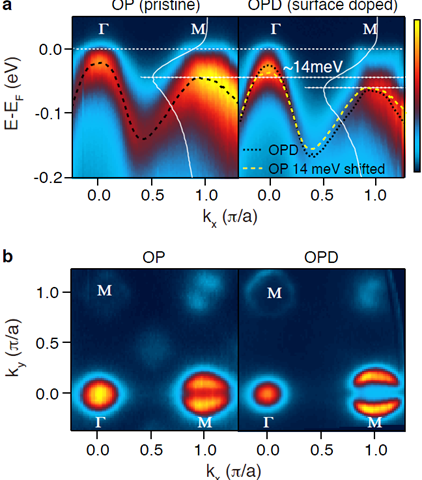#sodium
Simple logic for nanofluidic computing simulated
Invigorating the idea of computers based on fluids instead of silicon, researchers at the National Institute of Standards and Technology (NIST) have shown how computational logic operations could be performed in a liquid medium by simulating the trapping of ions (charged atoms) in graphene (a sheet of carbon atoms) floating in saline solution. The scheme might also be used in applications such as water filtration, energy storage or sensor technology.
The idea of using a liquid medium for computing has been around for decades, and various approaches have been proposed. Among its potential advantages, this approach would require very little material and its soft components could conform to custom shapes in, for example, the human body.
NIST’s ion-based transistor and logic operations are simpler in concept than earlier proposals. The new simulations show that a special film immersed in liquid can act like a solid silicon-based semiconductor. For example, the material can act like a transistor, the switch that carries out digital logic operations in a computer. The film can be switched on and off by tuning voltage levels like those induced by salt concentrations in biological systems.
Post link
Electrospun sodium titanate speeds up the purification of nuclear waste water
Electrospun sodium titanate speeds up the purification of water based on selective ion exchange – effectively extracts radio-active strontium
With the help of this new method, waste water can be treated faster than before, and the environmentally positive aspect is that the process leaves less solid radio-active waste.
The properties of electrospun sodium titanate are equal to those of commercially produced ion-exchange materials.
“The advantages of electrospun materials are due to the kinetics, i.e. reaction speed, of ion exchange,” says Risto Koivula, a scientist in the research group Ion Exchange for Nuclear Waste Treatment and for Recycling at the Department of Chemistry at the University of Helsinki.
Post link
Researchers discover a novel layered superconductor based on tin and arsenic
The layered superconducting material is characterized by a crystal structure in which a SnAs layer (wherein Sn and As are two-dimensionally bonded to develop superconductivity) and a Na layer (the spacer layer) are alternately laminated. Considering that such a layered structure is similar to that of a cuprate- or iron-based high-temperature (high-Tc) superconductor, it is possible that in SnAs-based layered materials, superconductivity is developed as a result of the unconventional pairing mechanism.
The research group of Yoshikazu MIZUGUCHI (Associate Professor) and Yosuke GOTO (Project Researcher) specializes in the discovery of two-dimensional layered structures—various materials can be designed by laminating different kinds of layers. As an example, in 2012, this research group also reported the discovery of novel layered superconducting material systems, Bi4O4S3 and LaO1-xFxBiS2, based on bismuth (Bi) and sulfur (S). To add, as the two-dimensional crystal structure gives rise to a low-dimensional electronic state, researchers are actively studying unique quantum phenomena such as high-temperature superconductivity.
Regarding NaSn2As2, Mizuguchi asserts that although the transition temperature of 1.3 K (-271.85°C) is not exactly high, it is anticipated that new materials will be developed based on the SnAs conductive layer, thereby clarifying the mechanisms underlying the increase of the transition temperature as well as those responsible for high-transition-temperature superconductivity.
Post link
Researchers create fiber optic sensors that dissolve in the body
For the first time, researchers have fabricated sensing elements known as fiber Bragg gratings inside optical fibers designed to dissolve completely inside the body. The bioresorbable fiber Bragg gratings could be used for in-body monitoring of bone fracture healing and for safer exploration of sensitive organs such as the brain.
A fiber Bragg grating is an optical element inscribed in an optical fiber, which is widely used as a sensing instrument. Although fiber Bragg gratings are commonly used for applications such as real-time monitoring of the structural health of bridges or tracking the integrity of airplane wings, until now they didn’t exhibit characteristics preferred for use in the body. With a design that allows them to break down similarly to dissolvable stitches, the new glass fibers should be safe for patients even if they accidently break, according to the researchers.
“Our work paves the way toward optical fiber sensors that can be safely inserted into the human body,” said Maria Konstantaki, a member of the research team from the Institute of Electronic Structure and Laser (IESL) of the Foundation of Research and Technology - Hellas (FORTH), Greece, that fabricated and characterized the new gratings. “Because they dissolve, these sensors don’t need to be removed after use and would enable new ways to perform efficient treatments and diagnoses in the body.”
Post link
PIEZO PRISM
Rochelle salt, aka potassium sodium tartrate tetrahydrate, NaKC4H4O6·4H2O, was the first material found to produce an electric discharge when compressed. This phenomenon, called piezoelectricity, is used in many lighters and grill starters. The salt is relatively easy to grow, says crystallization hobbyist Dmitry Shintyakov, so large, clear prisms like the one shown here are readily accessible. Shintyakov shares his methods online, so you can join the fun.
Credit: Dmitry Shintyakov
Cocrystals – C&EN’s Chemistry in Pictures
Post link
Enhanced electron doping on iron superconductors discovered
The Institute for Basic Science research team headed by the associate director of CCES, KIM Chang Young, presented the possibility of unifying theories to explain the working mechanism of iron- based superconductors.
Their research was published in Nature Materials on August 16th. Superconductors are a relatively new concept; they were brought to prominence in the late 80’s when two Nobel Prize winners discovered a new superconducting material. The basic principle of superconductivity arises when a superconducting material is cooled to a fairly low critical temperature allowing an electric current to flow without resistance.
Building on a Nobel Prize
The Nobel Prize winners reported their superconducting material - oxides which contain copper and rare earth metals - becomes a superconducting material below -250° Celsius, higher than the previous temperature of -269° Celsius. This led to a boom in developing similar materials for commercial use. Today’s research has moved on greatly; oxides are replaced with iron-based superconductors which are cheaper to mass produce and also permit a current to flow unabated. To understand the working mechanism of iron-based superconductors scientists have to significantly raise the transition temperatures to source the reason for the increase. Many researchers initially work on the assumption that the nesting effect is a dominant factor, especially in the case of pnictide superconductors {PSD}. Later, scientists discovered another type of superconductor, chalogenide superconductors {CSD}. Since it turned out that CSD is not subject to the nesting effect, the discovery of CSD generated controversy on the mechanism of their superconductivity. The nesting effect states when the surface temperature is increased, electrons become unstable thereby altering their properties both electrically and magnetically, allowing conductors to turn into superconductors.
Post link
Quantum material is promising ‘ion conductor’ for research, new technologies
Researchers have shown how to shuttle lithium ions back and forth into the crystal structure of a quantum material, representing a new avenue for research and potential applications in batteries, “smart windows” and brain-inspired computers containing artificial synapses.
The research centers on a material called samarium nickelate, which is a quantum material, meaning its performance taps into quantum mechanical interactions. Samarium nickelate is in a class of quantum materials called strongly correlated electron systems, which have exotic electronic and magnetic properties.
The researchers “doped” the material with lithium ions, meaning the ions were added to the material’s crystal structure.
The addition of lithium ions causes the crystal to expand and increases the material’s conduction of the ions. The researchers also learned that the effect works with other types of ions, particularly sodium ions, pointing to potential applications in energy storage.
Post link
Butterflies near salted roads grow larger eyes and muscles
by Sandhya Sekar
You might be able to cut the salt in your diet, but the wildlife near salted roads doesn’t have a choice. It’s not all bad, though – salt may boost the brawn of butterflies.
When roads are salted in icy conditions, some of the run-off is taken up by plants. To find out if raised sodium levels in roadside plants might affect animals that feed on them, Emilie Snell-Rood at the University of Minnesota, St Paul, and her colleagues assessed local monarch butterflies, which feed on milkweed plants.
The team found that milkweed plants at the roadside contained 16 times as much sodium as those 100 metres away from the road. The butterflies reared on these plants had, on average, 6 times as much sodium in their bodies as those reared on prairie plants, and were less likely to survive beyond the caterpillar stage. But sodium is essential for the development of nerve and muscle tissue in animals, and those butterflies that did survive on high-sodium leaves also experienced a growth spurt: males had bigger flight muscles and females had significantly larger eyes…
(read more: New Scientist)
photograph by Bruce Coleman Inc./Alamy
Post link

A rainbow airglow! Air glows all of the time, but it is usually hard to see. A disturbance, like a storm, may cause noticeable rippling in the Earth’s atmosphere. These gravity waves are oscillations in air, just like the ripples created when a rock is thrown in calm water. Makes sense right? But where do the colors come from? The deep red glow likely originates from OH molecules excited by ultraviolet light from the Sun. The orange and green airglow is likely caused by sodium and oxygen atoms slightly higher up. A spectacular sky is visible through this airglow, with the central band of our Milky Way Galaxy running up the image center, and M31, the Andromeda Galaxy, visible near the top left.
Image Credit & Copyright: Miguel Claro (TWAN); Rollover Annotation: Judy Schmidt
Βροχερή ημέρα, ενδείκνυται για ζεστό καφέ και ενημέρωση!
Το γάλα γαιδούρας περιέχει βιταμίνες Α1, Β1, Β2, C και Ε καθώς και ένα εξαιρετικό ποσοστό ανοσοσφαιρήνης, μαγνήσιο, ασβέστιο, κάλιο, φώσφορο, ψευδάργυρο και sodium.
Οι πρωτεΐνες γάλακτος προσφέρουν αξιόλογες ενυδατικές και θρεπτικές ιδιότητες, ως αποτέλεσμα της εξαιρετικής απορρόφησής τους από την επιδερμίδα, καθώς και της δυνατότητας τους να δεσμεύουν νερό. Παράλληλα απελευθερώνουν συγκεκριμένα αμινοξέα, τα οποία είναι πολύ σημαντικά συστατικά του φυσιολογικού ενυδατικού παράγοντα του δέρματος (ΝΜF) και της διατήρησης της φυσιολογικής μεταβολικής δραστηριότητας των κυττάρων, καθώς συμμετέχουν στη σύνθεση του κολλαγόνου, της ελαστίνης και της κερατίνης. Όλα αυτά τα χαρακτηριστικά προάγουν τη δημιουργία ενός υγροσκοπικού φιλμ στην κεράτινη στοιβάδα της επιδερμίδας.
#Rainy #day, indicated for hot #coffee and #update!
#Donkey #milk contains #vitamins A1, B1, B2, C and E and an #excellent rate of #immunoglobulins, #magnesium, #calcium, #potassium, #phosphorus, #zinc and #sodium.
The milk #proteins offer #remarkable #hydrating and #nutritional #properties, as a #result of their excellent #absorption into the #skin, and the #ability to #bind #water. Furthermore, they release specific #amino #acids, which are very #important #components of the #normal skin #moisturizing #factor (NMF) and of #preservation of the normal #metabolic #activity of #cells, as they are involved in the #synthesis of #collagen, #elastin and #keratin. All these #characteristics #promote the #creation of a #hydroscopic #film on the #stratum #corneum of our skin.
Post link
I saw my GP this morning regarding both my loperamide prescription (I’ve been having a reaction to the liquid so needed a new script for the instand melt tablets) and my rehydration methods. She said she was happy to do a monthly prescription for 112 instant melt tablets of loperamide and I can always adjust the dose as I need to. So that’s one thing fixed relatively easilly.
When talking about my rehydration, she admitted she wasn’t as knowledgable about it so she would email my dietitian for me. I explained my reasons for no longer having the St Mark’s rehydration solution and that I was instead drinking Lucozade and a suppliment drink called Sneak as both have a somewhat decent amount of sodium/salt.*
As I had a blood test just yesterday (Thurday) morning, she had a look at the results and it showed that my sodium was back to normal levels as were pretty much everything else. I asked if I should keep going with what I am doing and she agreed. She said she was still going to email my dietitian just to keep them in the loop which I am more than happy for her to do.
All in all, A good visit to the doctor. I just need to wait for my loperamide to be ready.
*Just a quick disclaimer: I am drinking Lucozade and Sneak suppliment drinks as a replacement for the St Mark’s rehydration solution as this works better for me personally. Please do not change or stop your rehydration methods recommended by you specialist/GP/dietitian without talking to them about it in detail first. Be safe.
(or “i now have downloaded a mod for another mod for a mod’s API for a mod loader so that a mod can properly use another mod loader’s API to display the first mod correctly. this is now how minecraft modding works.)
Like any good Minecrafter from the bygone era of days past, I’ve been using and recommending Optifine as nearly a mandatory addition to Java Edition for as long as I’ve been playing the game. This hasn’t changed as the years go on, I loyally follow the Optifine branch for the latest edition. When I first heard of the Sodium magic, I was interested in a up and coming replacement for Optifine’s chunky codebase, but then the fine print of excluding all, save performance enhancements jumped out at me.
As the project and months progress, I still find the general temperament of Sodium’s community displeasing, and the blasé snide comments of “just add it in yourself if you want it” grating on myself, doubly-so as a creator who just wants the game to work smoothly. The exclusion of even basic Optifine features like a zoom button in Sodium (which must be added in via a mod), alongside a general niche zone for CIT support in general made it near-impossible to me to consider the switch.
Until my hand was forced, and I was told in one scoffing remark to piece together that a mod author no longer supports Optifine. Alright, bet.
Let me be very clear about my criticism here: Sodium is a fantastic performance mod and the changes of excluding all features save performance is, in part, from fear of becoming a lumbering Optifine with years of technical debt. However, the random names, featuresets, and lack of coherency to Sodium-adjacent mods serve to confuse any moderately computer-savvy individual with their expanding levels of complexity.
This new reliance on swapping one core mod to another mod that decided it’s strictly a performance mod– and everyone else can go stick it where the sun doesn’t shine is infuriating, needlessly confusing, and needs to be paired down into a controlled bundle release with multiple developers collaborating together.
The more mods you add into this soup, the more devs that join in the stirring, the more features diverge and the less “good soup” vibes I get trying to set up an installation of 1.17.1.
Sodium has lost that singular advantage of a clean codebase and lack of technical debt. Names make no sense, or are vague and require you to infer exactly what the dev is talking about coyly. Technical features that should be part of Sodium, like a basic access to the Fabric Rendering API doesn’t exist and instead must be added by another mod so that your Sodium-adjacent mod can use a Fabric API feature correctly to load itself inside of Sodium.
I am going mad.
Legitimately, I am going mad:
Fabric API, Fabric Language Kotlin, BFAPI
Core mod library and API support for most Fabric mods.
Sodium + Iris Bundle
Replaces Optifine with core performance enhancements and new rendering system for the game, alongside shader support from Optifine and specific performance edits made to Sodium for shaders.
Indium
Required core sub-mod for a majority of Sodium-adjacent mods, adding API access to the Fabric Rendering API.
LambdaBetterGrass
Requires Indium. Adds back in the Better Grass toggle from Optifine.
LamdbaDynamicLights
Requires Indium. Adds back in dynamic lighting from Optifine.
Continuity
Provides support for Optifine connected textures and glass pane fixes.
CIT Resewn
Standalone Fabric mod to use CIT resource packs outside of Optifine.
That is… *drumroll* ten mods total! Holy shit! Ten mods to even reach maybe-parity for creative Optifine features, and probably not counting all of the little visual things I still need to hunt down a mod for, figure out if it’s stable or not, figure out if it’s supported or not, check it’s for the correct 1.17 release, then check if it’ll crash my game. How am I supposed to make a tutorial for this???
At least I have a base to start working from.
…it’s all upwards from here?
edit - 27 December 2021:
Here’s my current Sodium-based setup for 1.17, ymmv:
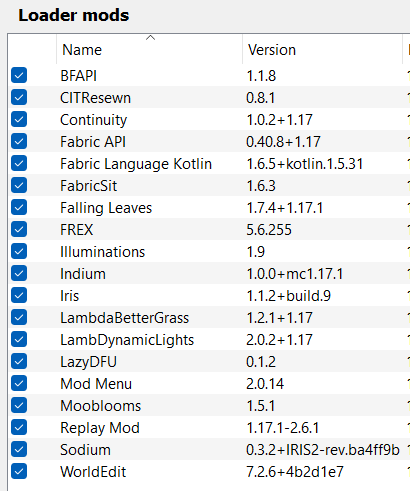
And my current Sodium-based setup for 1.18:
(minus a working ReplayMod and with the new Iris/Sodium split)




